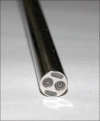Three-dimensional laparoscopy: Principles and practice
- PMID: 27143695
- PMCID: PMC5485803
- DOI: 10.4103/0972-9941.181761
Three-dimensional laparoscopy: Principles and practice
Abstract
The largest challenge for laparoscopic surgeons is the eye-hand coordination within a three-dimensional (3D) scene observed on a 2D display. The 2D view on flat screen laparoscopy is cerebrally intensive. The loss of binocular vision on a 2D display causes visual misperceptions, mainly loss of depth perception and adds to the surgeon's fatigue. This compromises the safety of laparoscopy. The 3D high-definition view with great depth perception and tactile feedback makes laparoscopic surgery more acceptable, safe and cost-effective. It improves surgical precision and hand-eye coordination, conventional and all straight stick instruments can be used, capital expenditure is less and recurring cost and annual maintenance cost are less. In this article, we have discussed the physics of 3D laparoscopy, principles of depth perception, and the different kinds of 3D systems available for laparoscopy. We have also discussed our experience of using 3D laparoscopy in over 2000 surgeries in the last 4 years.
Conflict of interest statement
There are no conflicts of interest.
Figures




Similar articles
-
Three-dimensional (3D) versus two-dimensional (2D) laparoscopic adrenalectomy: A case-control study.Int J Surg. 2016 Apr;28 Suppl 1:S114-7. doi: 10.1016/j.ijsu.2015.12.055. Epub 2015 Dec 18. Int J Surg. 2016. PMID: 26708842
-
Influence of 3D laparoscopic surgery on surgeon's visual pattern and mental workload.J Med Eng Technol. 2021 Jul;45(5):375-379. doi: 10.1080/03091902.2021.1907466. Epub 2021 Apr 12. J Med Eng Technol. 2021. PMID: 33843431
-
Randomized study of the influence of two-dimensional versus three-dimensional imaging using a novel 3D head-mounted display (HMS-3000MT) on performance of laparoscopic inguinal hernia repair.Surg Endosc. 2018 Nov;32(11):4624-4631. doi: 10.1007/s00464-018-6215-z. Epub 2018 May 17. Surg Endosc. 2018. PMID: 29777354 Clinical Trial.
-
Two-Dimensional Versus Three-Dimensional Laparoscopic Systems in Urology: A Systematic Review and Meta-Analysis.J Endourol. 2018 Sep 12;32(9):781-790. doi: 10.1089/end.2018.0411. J Endourol. 2018. PMID: 29969912 Free PMC article.
-
Robotic surgery in gynecology.J Minim Access Surg. 2015 Jan-Mar;11(1):50-9. doi: 10.4103/0972-9941.147690. J Minim Access Surg. 2015. PMID: 25598600 Free PMC article. Review.
Cited by
-
Different classes of videoscopes and direct laryngoscopes for double-lumen tube intubation in thoracic surgery: A systematic review and network meta-analysis.PLoS One. 2020 Aug 28;15(8):e0238060. doi: 10.1371/journal.pone.0238060. eCollection 2020. PLoS One. 2020. PMID: 32857788 Free PMC article.
-
The Role of Three-dimensional Laparoscopy in Gynecology: Time to Revise Our Perspective?Gynecol Minim Invasive Ther. 2023 Dec 7;13(1):1-3. doi: 10.4103/gmit.gmit_99_23. eCollection 2024 Jan-Mar. Gynecol Minim Invasive Ther. 2023. PMID: 38487617 Free PMC article. No abstract available.
-
Role of haptic feedback technologies and novel engineering developments for surgical training and robot-assisted surgery.Front Robot AI. 2025 Jun 4;12:1567955. doi: 10.3389/frobt.2025.1567955. eCollection 2025. Front Robot AI. 2025. PMID: 40534772 Free PMC article. Review.
-
Three-dimensional laparoscopic Roux-en-Y gastric bypass with totally hand-sewn anastomoses for morbid obesity. A single center experience.Acta Cir Bras. 2020 Sep 7;35(8):e202000806. doi: 10.1590/s0102-865020200080000006. Acta Cir Bras. 2020. PMID: 32901683 Free PMC article.
-
Associations Between Binocular Depth Perception and Performance Gains in Laparoscopic Skill Acquisition.Front Hum Neurosci. 2021 Oct 5;15:675700. doi: 10.3389/fnhum.2021.675700. eCollection 2021. Front Hum Neurosci. 2021. PMID: 34675789 Free PMC article.
References
-
- Yuen PM, Yu KM, Yip SK, Lau WC, Rogers MS, Chang A. A randomized prospective study of laparoscopy and laparotomy in the management of benign ovarian masses. Am J Obstet Gynecol. 1997;177:109–14. - PubMed
-
- Lo L, Pun TC, Chan S. Tubal ectopic pregnancy: An evaluation of laparoscopic surgery versus laparotomy in 614 patients. Aust N Z J Obstet Gynaecol. 1999;39:185–7. - PubMed
-
- Sinha R, Sundaram M, Raje S, Rao G, Sinha M, Sinha R. 3D laparoscopy: Technique and initial experience in 451 cases. Gynecol Surg. 2013;10:123–8.
-
- Blavier A, Gaudissart Q, Cadière GB, Nyssen AS. Impact of 2D and 3D vision on performance of novice subjects using da Vinci robotic system. Acta Chir Belg. 2006;106:662–4. - PubMed
-
- Izquierdo L, Peri L, García-Cruz E, Musquera M, Ciudin A, Pérez M, et al. 3D advances in laparoscopic vision. Eur Urol Rev. 2012;7:137–9.
Publication types
LinkOut - more resources
Full Text Sources
Other Literature Sources
Medical
